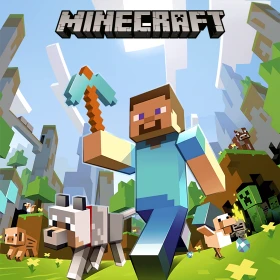Navigating the expansive world of Minecraft, players often seek the thrill of exploration and the efficiency of fast travel. Among the myriad of ways to traverse the vast landscapes, learning how to tame a horse in Minecraft stands out as a rewarding and practical skill. This important aspect of the game not only enhances mobility but also adds a layer of strategy in horse breeding, equipping for defense, and mastering the mechanics of horse jump to overcome obstacles. The bond between a player and their horse becomes a cornerstone of their Minecraft adventure, making the mastery of horse taming an essential element of gameplay.
This article offers a comprehensive guide on meticulously taming a wild horse, from the initial steps of finding the right white horse to understanding how to saddle a horse in Minecraft for optimal control and utility. Readers will learn the nuances of horse feeding, the significance of horse armor for protection, and the advanced techniques involved in horse breeding for creating the perfect companion. Additionally, practical tips on how to ride a horse in Minecraft, enhance its jump capabilities, and effectively utilize the horse for exploration and combat are covered, providing a thorough roadmap for both novice and expert players aiming to master the art of horse taming in Minecraft.
Understanding Minecraft Horses
Identifying Different Horse Types
Minecraft features a diverse range of horse types, each with unique characteristics and uses. The standard horses come in 35 different colors and can be equipped with saddles and horse armor, making them versatile for travel and combat. Donkeys, on the other hand, are smaller and slower but excel in carrying items due to their ability to be equipped with chests. Mules are a hybrid of donkeys and horses, combining speed with the utility of carrying chests. Additionally, Minecraft includes special undead horses such as Skeleton Horses and Zombie Horses. Skeleton Horses can be ridden underwater and are obtained by defeating a skeleton rider, whereas Zombie Horses do not naturally spawn and must be summoned through commands.
Benefits of Taming and Riding Horses
Horses significantly enhance mobility in Minecraft, allowing players to cover large distances quickly and efficiently. Taming and riding horses provide several advantages:
- Speed and Agility: Horses can move faster and jump higher than players, which is crucial for exploring new terrains and evading hostile creatures.
- Utility: Equipped horses can carry chests and wear armor, increasing a player's capacity to transport goods and survive in combat.
- Companionship: Riding a horse adds a dynamic of companionship and strategy, as players must care for and protect their horse companions.
- Accessibility: Horses can navigate terrains that are challenging for players on foot, such as climbing hills and jumping over obstacles.
Understanding these horse types and their benefits is essential for players looking to enhance their Minecraft experience through effective mobility and utility.
Finding a Wild Horse
In the immersive world of Minecraft, finding a wild horse marks the beginning of an adventurous journey with a new companion. These majestic creatures spawn in specific biomes, and understanding where and how to locate them is crucial for any player looking to tame a horse. This section delves into the biomes where horses commonly spawn and offers practical tips for locating horse herds efficiently.
Biomes Where Horses Spawn
Horses in Minecraft have distinct spawning patterns that players can leverage to find them. They predominantly appear in plains and savannas, where they roam in herds of two to six. An interesting aspect of their spawning is that all horses in a herd share the same color, although their markings can vary. This uniformity in color but diversity in markings adds a layer of intrigue when searching for the perfect horse to tame.
In addition to wild plains and savannas, horses can also be found within the confines of Minecraft villages. Here, they naturally generate in stables or animal pens, providing an alternative source for players to find these creatures. The presence of horses in villages underscores their importance in the game, not just as a mode of transportation but also as a vital element of village life.
Tips for Locating Horse Herds
-
Identify the Biome: The first step in finding a wild horse is to ensure you're in the right biome. Plains and savannas are your go-to locations. You can verify you're in a plains biome by the landscape's appearance or by pressing F3 to see the biome name.
-
Explore Villages: Don't overlook the villages. Horses spawn naturally in village stables and animal pens. Exploring these areas can often lead to finding a horse without the need to search the wild.
-
Look for Herds: Horses spawn in groups, so if you spot one, there are likely more nearby. Keep an eye out for herds as they roam the biome. Remember, all horses in a herd will have the same color but may have different markings, adding variety to your options.
-
Patience and Persistence: Horses are somewhat rare, and their spawning in a plains or savanna biome is not guaranteed. If you don't find a horse in one location, try exploring another area within the same biome or check another plains or savanna biome altogether.
By following these steps and keeping an eye on the specific biomes and village structures, players can increase their chances of finding a wild horse. Once located, the journey of taming and bonding with your new horse companion can begin, opening up new possibilities for exploration and adventure in the vast world of Minecraft.
Taming Your Horse
Taming a horse in Minecraft is a rewarding experience that enhances your adventure and mobility within the game. This process requires patience, understanding, and a bit of strategy. Below are detailed steps and tips to successfully tame your horse.
Approaching the Horse
The first step in taming a horse involves approaching it correctly. One must ensure their hotbar is selected to an empty slot because using your hand is essential for taming the horse. This initial interaction is crucial as it sets the stage for a successful taming process.
Repeated Attempts to Mount
After approaching the horse, the next step is to attempt to mount it. This can be achieved differently depending on the version of Minecraft you are playing:
- For Java Edition (PC/Mac), right-click on the horse.
- For Pocket Edition (PE), move your pointer over the horse and press the
Mountbutton. - For Xbox 360 and Xbox One, press the LT button on the Xbox controller.
- For PS3 and PS4, press the L2 button on the PS controller.
- For Wii U, press the ZL button on the gamepad.
- For Nintendo Switch, press the ZL button on the controller.
The horse will likely buck you off during your initial attempts. Each time you are knocked off, it is important to try to mount the horse again. With each attempt, the horse will allow you to sit on it a bit longer before it bucks you off. Persistence is key here. When the horse is finally tamed, red hearts will appear all around it, indicating that it will no longer buck you off.
Feeding for Faster Taming
To expedite the taming process, feeding the horse can significantly increase your chances. Different foods have varying effects on the taming process:
| Food Item | Percentage Increase in Taming Chance |
|---|---|
| Sugar, Apple, Wheat | 3% |
| Golden Carrot | 5% |
| Golden Apple | 10% |
While feeding the horse these items can make the taming process quicker, it's worth noting that golden carrots and golden apples are also valuable for breeding horses. Therefore, one might consider saving these items for that purpose.
By following these steps and utilizing the tips provided, players can successfully tame a horse in Minecraft. This process not only adds a valuable companion to your Minecraft adventures but also opens up new possibilities for exploration and utility within the game.
Riding and Controlling Your Horse
Once a player has successfully tamed a horse in Minecraft, the next step is to equip it with a saddle and possibly armor, allowing for full control over the horse's movements. This section will guide players through equipping a saddle, navigating and jumping with their horse, and managing water hazards.
Equipping a Saddle
To ride and control a horse, one must first equip it with a saddle. Saddles cannot be crafted and must be found in dungeons, fishing, or trading with villagers. After taming the horse, approach it and access its inventory by pressing the appropriate button (such as the triangle button on PlayStation controllers). Then, drag the saddle from your inventory to the saddle slot on the left side of the horse's picture. Once equipped, the horse's appearance will change to show it wearing the saddle, signifying it's ready to be ridden and controlled.
Navigating and Jumping
Riding a horse offers enhanced mobility, allowing players to cover ground faster and jump higher than on foot. To ride, simply mount the tamed and saddled horse and use the standard movement controls to navigate. Horses can walk over flat land and blocks up to 1 block high. For jumping, players need to hold down the jump button (space bar on PC) until the jump bar reaches its maximum, then release to leap. The jump strength varies among horses, with some able to clear obstacles up to 5 blocks high. This capability makes horses invaluable for exploring difficult terrains and climbing hills or fences.
Water Hazards and Precautions
While horses are versatile creatures, they have limitations when it comes to water. Horses can safely traverse water up to 1 block deep. However, attempting to ride through water deeper than this will result in the player being dismounted, and the horse may start to drown. To prevent this, players should use a lead to guide the horse out of deep water. For crossing larger bodies of water, consider using a boat. Attach a lead to the horse, then pull it behind the boat as you navigate the water. This method ensures the horse's safety and allows players to continue their journey without interruption.
| Action | Control/Instruction |
|---|---|
| Equip Saddle | Access horse inventory, move saddle to saddle slot |
| Ride Horse | Mount the horse, use standard controls for movement |
| Jump with Horse | Hold and release the jump button, considering the horse's jump strength |
| Navigate Water | Use leads or boats for deep water, avoid water deeper than 1 block |
By following these steps and tips, players can fully enjoy the benefits of riding and controlling a horse in Minecraft. Whether it's for exploration, combat, or simply enjoying the scenery, mastering these aspects will enhance the overall Minecraft experience.
Equipping Your Horse for Utility and Protection
Using Chests with Donkeys and Mules
Donkeys and mules in Minecraft serve not only as modes of transportation but also as essential pack animals. These creatures can be equipped with chests, significantly increasing their utility by providing additional inventory slots. To equip a chest on a tamed mule or donkey, players must first ensure the animal is saddled. Once saddled, the process involves the following steps:
- Prepare the Chest: Have a chest ready in your inventory.
- Approach the Donkey or Mule: Walk up to your tamed and saddled donkey or mule.
- Equip the Chest: Right-click on the donkey or mule with the chest in hand. This action equips the chest and grants the animal additional storage slots.
A mule equipped with a chest gains 15 extra inventory slots, allowing players to carry more items on their adventures. It's important to note that once a chest is attached, it cannot be removed unless the mule is killed, at which point it drops both the chest and its contents.
Horse Armor Types and Benefits
Equipping horse armor is crucial for protecting your horse from damage during combat or while exploring hazardous environments. Minecraft offers several types of horse armor, each providing different levels of protection:
| Material | Armor Value | Notes |
|---|---|---|
| Leather | 3 | Can be dyed; protects against freezing in snow |
| Iron | 5 | Common, offers moderate protection |
| Gold | 7 | More protective than iron; no durability concerns |
| Diamond | 11 | Highest protection; no durability concerns |
To equip horse armor, follow these steps:
- Obtain Horse Armor: Find armor through dungeon chests, trading, or other exploration activities.
- Approach Your Horse: Walk up to your tamed horse.
- Equip the Armor: Press 'E' to open your inventory while riding the horse, or right-click the horse with the armor in your hand, placing it in the armor slot.
Notably, horse armor in Minecraft does not suffer from durability issues, meaning it does not wear out with use. This feature allows players to use the same set of armor indefinitely, providing lasting protection for their horse. Additionally, unlike player armor, horse armor cannot be enchanted through conventional means, ensuring straightforward utility without the complexities of enchantments.
Advanced Tips for Expert Riders
Jumping Techniques and Height
To maximize the jumping capabilities of horses in Minecraft, understanding and measuring the jump strength is crucial. The internal jump strength value for horses ranges from 0.4 to 1.0, correlating to a jump height of approximately 1.11 to 5.3 blocks. Players can create a simple testing device by building walls of increasing heights, spaced 3 blocks apart. By attempting to jump over these walls sequentially, players can determine the maximum height their horse can achieve. Additionally, using slabs and snow layers allows for precision in measuring non-full block increments, aiding in fine-tuning jump training.
Optimizing Speed and Agility
Speed is a critical attribute for horses, significantly affecting gameplay. The internal speed value for horses varies between 0.1125 and 0.3375. To measure this, players can set up a track with a long chain of repeaters. Using a piston to release the horse synchronously with a pulse down the repeater chain, players can track the speed by noting where the pulse freezes upon the horse triggering a pressure plate at the end of the track. For practical application, multiplying the internal speed value by 42.16 gives the speed in blocks per second, providing a clear metric to gauge and enhance a horse's performance in Minecraft.
Combat Strategies on Horseback
Effective combat on horseback requires strategic use of the horse's speed and jump abilities. Horses can be formidable in combat scenarios, particularly when equipped with bows. Players can maintain a distance from mobs, using the horse's mobility to avoid close combat while shooting arrows. This tactic is especially potent against skeletons, which are easier to rush due to their slower movement. However, sword fighting on horseback can be challenging due to difficulties in maneuvering and targeting. It's advised to avoid fighting in tight spaces, such as caves or dense forests, where mobility is restricted. Instead, leveraging open fields where the horse's speed and agility can be fully utilized will yield better combat outcomes.
Conclusion
Throughout this guide, we've embarked on an in-depth journey through the world of Minecraft, exploring the multifaceted process of horse taming, from initial encounters with wild horses to mastering the techniques of riding, equipping, and engaging in combat with these noble steeds. We've covered the essentials of identifying varying horse types, optimizing their utility with armor and chests, and the strategic elements of riding and combat, equipping both novice and adept players with the knowledge to enhance their Minecraft adventures. The significance of these skills resonates beyond mere gameplay, weaving a narrative of companionship and strategy that elevates the experience to new heights.
The collaborative dance between player and horse, enriched by patience and understanding, ultimately culminates in a rewarding alliance that traverses the game's vast landscapes. This guide underscores not only the practical aspects of mobility and protection but also the profound impact of nurturing a bond with your Minecraft horse, opening avenues for exploration and combat previously uncharted. As players continue to venture into the endless possibilities of Minecraft, the knowledge and techniques shared here will serve as a steadfast companion, guiding them toward mastering the art of horse taming and paving the way for memorable adventures that lie ahead.
FAQs
How do I go about taming a horse in Minecraft, following a step-by-step approach?
To tame a horse in Minecraft, approach it and repeatedly attempt to mount it. Each time you're thrown off, try again. Eventually, the horse will accept you as its rider, indicated by hearts appearing around it. This process may require several attempts but is straightforward once you get the hang of it.
What's the simplest method to tame a horse in Minecraft?
The easiest way to tame a horse in Minecraft involves continuously trying to mount the horse until it no longer bucks you off. This method, while requiring patience, is effective and straightforward.
On average, how many attempts will it take to tame a horse in Minecraft?
Typically, you have about a 5% chance to tame a horse on your second try, and it's common to successfully tame a horse within six tries. However, luck plays a role, and it might take more attempts in some cases.
How can I control and ride a horse after taming it in Minecraft?
Once you've tamed a horse in Minecraft, you can control and ride it by using a saddle. Place the saddle on the horse by opening your inventory while mounted on the horse, then moving the saddle to the appropriate slot on the horse. This will allow you to steer and ride the horse across the Minecraft world.








Comments